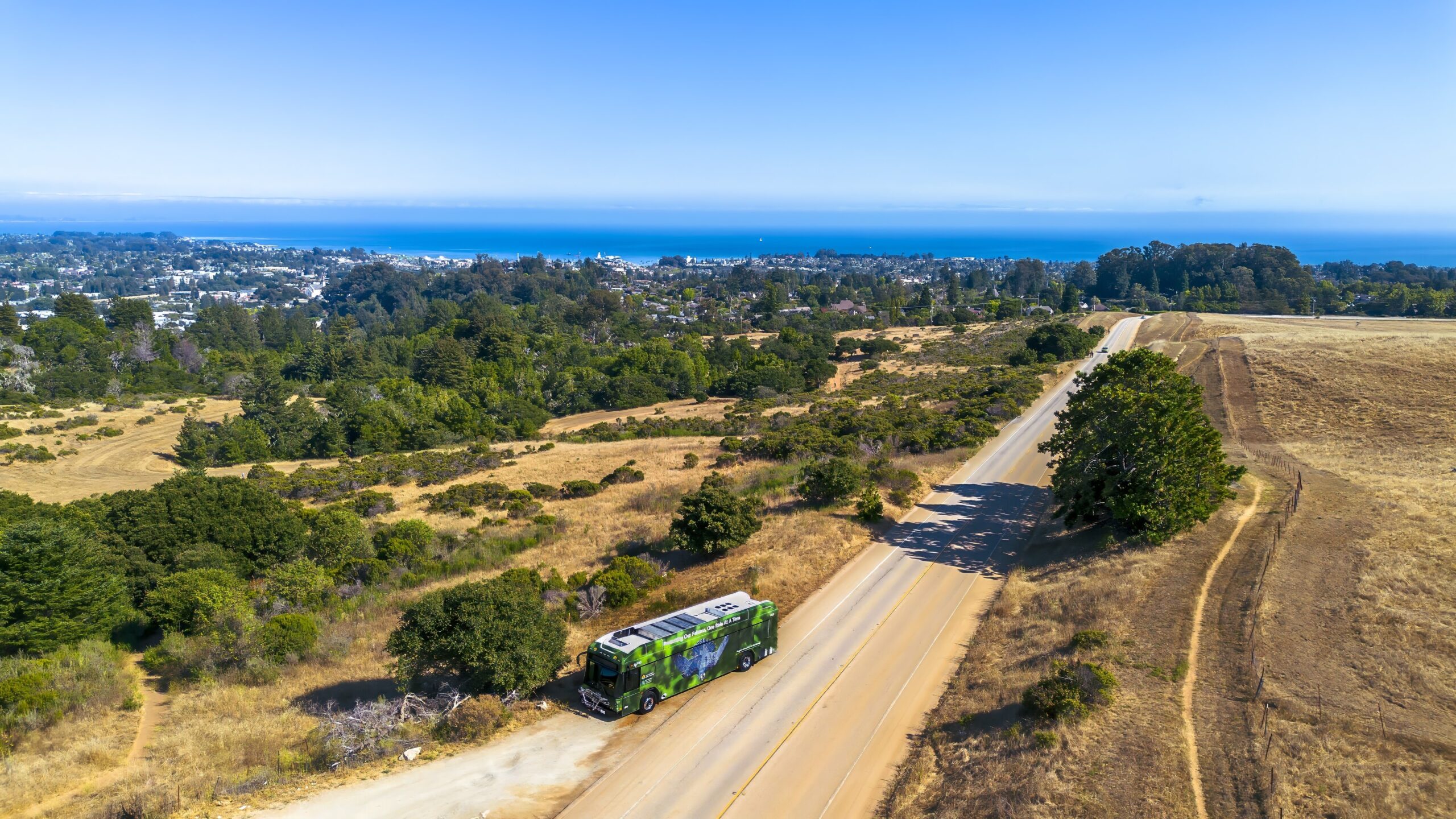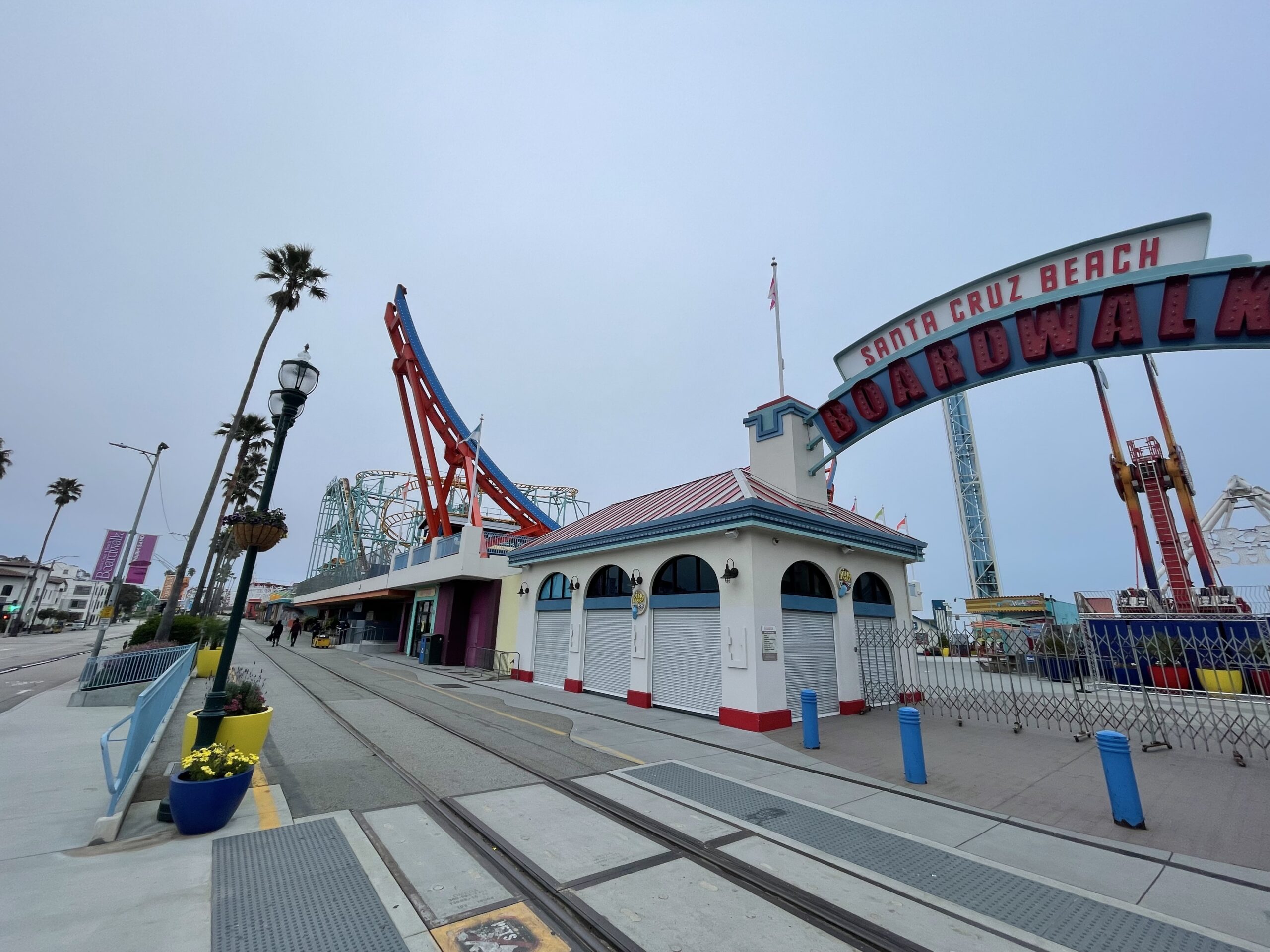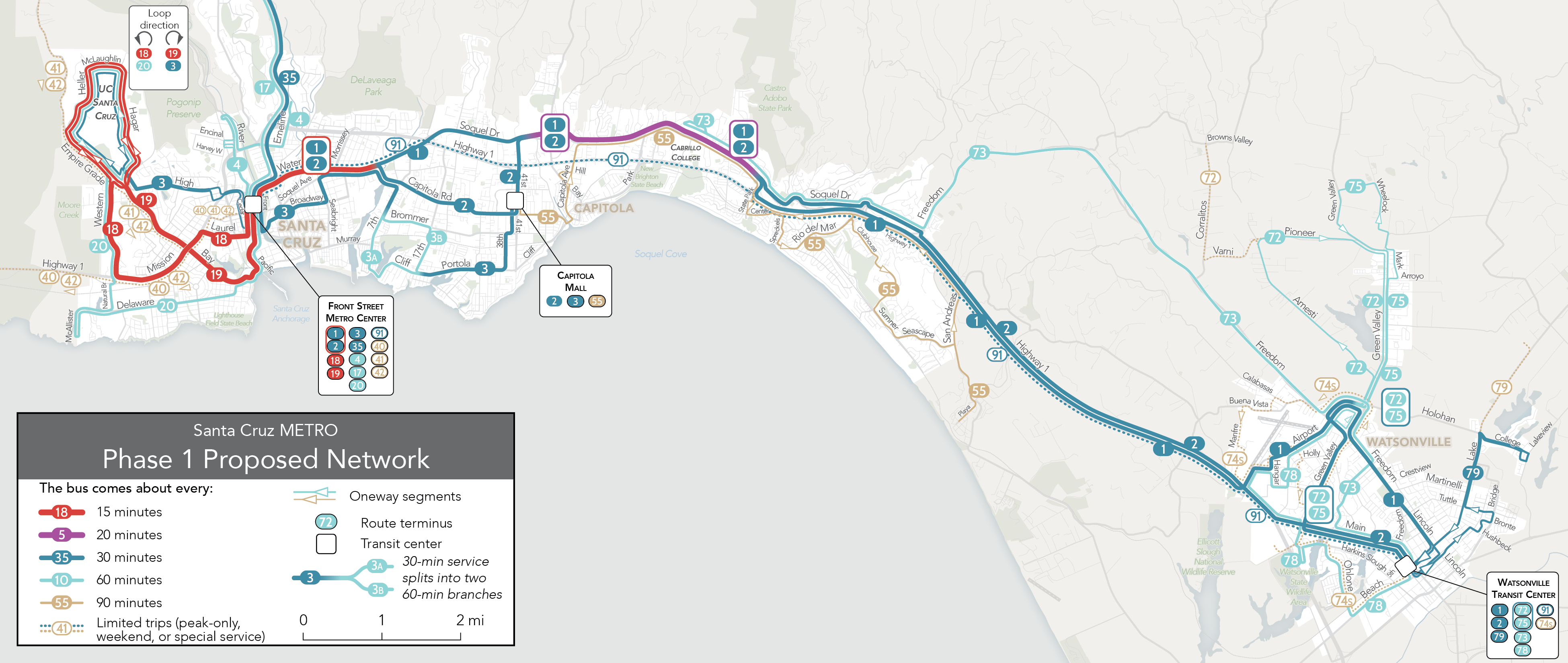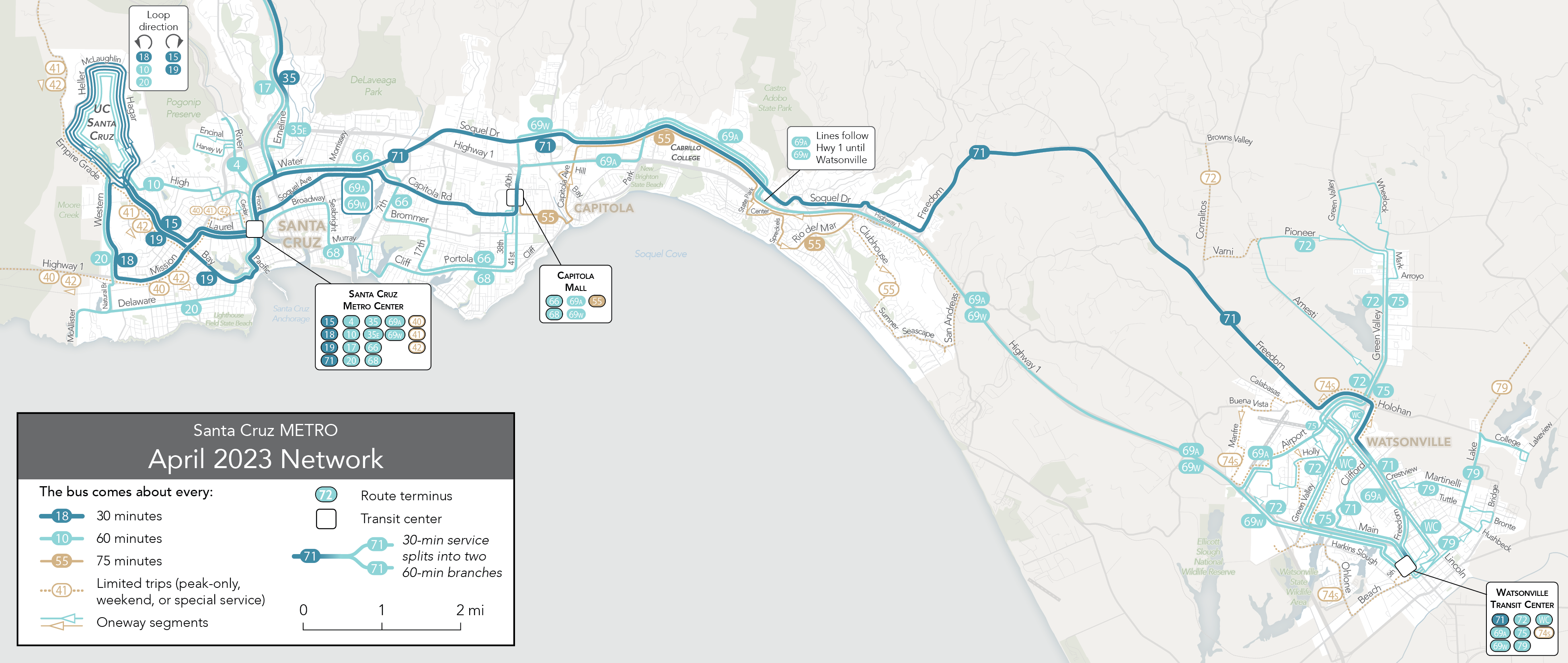 While you’ve heard plenty about big US agencies facing a “fiscal cliff,” some agencies are doing well and expanding their offerings as their staffing permits. That includes Portland and Dallas, where we’ve been working, but here’s a similar story from a smaller agency in an outrageously beautiful place.
While you’ve heard plenty about big US agencies facing a “fiscal cliff,” some agencies are doing well and expanding their offerings as their staffing permits. That includes Portland and Dallas, where we’ve been working, but here’s a similar story from a smaller agency in an outrageously beautiful place.
Santa Cruz County, just south of the San Francisco Bay Area, is known for its beautiful beaches, towering redwoods, college-town ambience, and expensive housing, but the county also contains Watsonville, on the edge of the agricultural Salinas Valley, which has cheaper housing and is over 80% Hispanic or Latino/a. The University of California at Santa Cruz (UCSC) generates huge demand to its hilltop campus at the west end of the region, but Watsonville generates strong demand for travel both locally and to jobs in Santa Cruz. Meanwhile, the City of Santa Cruz is trying to encourage denser housing along frequent transit corridors in order to address their problems of housing affordability.

Like many US agencies, Santa Cruz Metro had to make cuts during the pandemic to match the service to their shortage of bus drivers. In the last year, though, the pace of hiring has picked up, and the agency can do its first substantial expansion. They asked us to analyze the network and develop some concepts for improvement. We drafted a couple of alternatives, and had a public conversation about them. Finally, last Friday, the agency’s Board adopted a Phase 1 restructuring plan. By then, it turned out, hiring had gone even better than expected and some hard choices that we had feared would have to be made turned out not to be necessary.
Phase 1, now scheduled for implementation this December, will change the network completely. It currently looks like this. (As always, click maps to enlarge and sharpen.)
Starting in December it will look like this.
Look at the legend! As always, colors on these maps represent frequency, and that’s fundamental to understanding how this network is better than the old one.
The existing system has no service running better than every 30 minutes, but it also has no timed connections, so waits are long, not just for your initial bus but also for the bus you may be connecting to. The redesign increases frequencies, improves the timing of connections, and streamlines and simplifies the network.
It’s an especially big change in Watsonville, whose confusing tangle of overlapping hourly routes was especially useless for most trips. There, service is restructured to put a majority of the population and jobs near half-hourly service, mostly on lines that run through to the other cities to the west.
In Santa Cruz, the big change is the restoration of 15-minute frequency on the main lines that connect the University of California (“UC Santa Cruz” on the map) with the westside and downtown. This is important not just for the university, but also to support the City’s goals for denser residential developments in the existing neighborhoods south of the campus.
The spine of the network linking Watsonville and Santa Cruz is a braid of four hourly routes currently called 69A, 69W, and 71. In the new network the same resources go into simpler routes 1 and 2, and they’re more precisely scheduled to provide a 15-minute frequency on their westernmost segment where they run together. Halfway between Santa Cruz and Watsonville, these two routes combine again to serve Cabrillo College, the only community college in the county. We have shown the frequency there as every 20 rather than every 15 because if Routes 1 and 2 leave downtown Santa Cruz spaced evening every 15 minutes, they won’t be as evenly spaced at Cabrillo College, since Route 2 will have taken a longer path. Still, this is a significant frequency improvement for the county’s biggest transit destination outside the University.
Santa Cruz Metro is rolling out this change very fast, aiming to have the new service on the street in December. Meanwhile, this is just the first phase of a more ambitious expansion that will be discussed with the public soon in hopes of further frequency expansions in 2024. That next phase would extend high-frequency local-stop service to Watsonville, while also adding an all-day Santa Cruz-Watsonville Express. It will also look at new continuous service from the University to the east side of Santa Cruz. We look forward to a robust public discussion of that next phase.
At our firm, we are ready to help any transit agency work with its financial situation, whatever it is. But it’s especially exciting to see a transit agency that’s able to grow its services to match the values and ambitions of the communities it serves.

The solution for the loops in UC Santa Cruz is interesting, looks unnecessarily complicated on the map. I would probably have designed it in another way. One of the 18 or 19 could go Empire Grade in both directions, and the other one could go Hagar in both directions. Of course with through-running so that 18 becomes 19 and vice versa where the routes end. Then each route would go the same way in both directions. On the other hand, your solution might be easier to explain since the buses stay on the same route.
Also, the maps are great as usual. I like that you distinguish routes by maximum wait time instead of number of buses per hour. I personally can’t distinguish the colors for 20 and 30 minutes but I see that the 1/2 in Cabrillo College is wider so I conclude that it must be the 20 minute line.
On the whole this is a very good proposal, and shorn of the several options under consideration this summer, it looks even better. I have been drawing SC Metro transit routes on my Trails of Santa Cruz map since 2000, and by the 2017 4th edition it had withered to mostly hourly routes (enough you’d have to be lucky or persistent to use it for transit+walking trips, not to mention in daily living). And yet the routes have good bones. Cutting the complexity, backing up the chosen options with data, I look forward to seeing how it plays out (phase 2 included).
Jarrett,
I lived in the Watsonville area and commuted to Santa Cruz for many years. Santa Cruz Metro was pretty useless for me; I was basically forced to drive Highway 1. So I’m pleased to see the infrequent and rambling route 71 moving towards a more frequent and direct Santa Cruz-Watsonville service (proposed routes 1 and 2). My question is: Are you looking ahead at how Metro might integrate with a future coastal commuter rail route–now that Measure D is behind us?
Our project is short-range, just things to be done in 2023-5, so it’s not on the right timescale to coordinate with future rail expansion. But I know that others are working on those issues.
Does anyone here know if Kirk D. Schneider, author of the California Transit Guide from the 1990s, is still alive, and if so, how to reach him? I am interested in publishing a book in a similar style about other states, and wish to seek permission.
Kirk is apparently alive and still working in transportation. You can find him on LinkedIn. Look for the Kirk Schneider of Fullerton, California, transportation consultant.
Thank you.
I find it interesting that there’s no talk of service to the San lorenza valley which includes Boulder Creek Ben Lomond and Felton what we really need is for the bus system to start earlier so that we can make the 17 Express and go over the hill to go to work Right now can’t even get to Felton before 8:00 a.m. during the week and 9:00 a.m. on the weekends so if I have a job at wild Roots and Felton and I live in Boulder Creek and I need to start at 6:00 that’s not going to happen these jobs pay minimum wage and most people can’t afford to buy a car in those wage schedules. The system is supposed to keep people off the street if possible looks to me like we’re only interested in the children that are going to UCSC and have plenty of money from their families to support them. Let’s make sure and protect the elites never mind the people that are trying to come up.